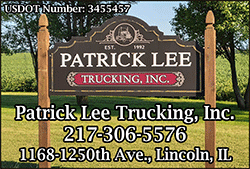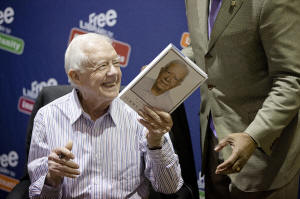Jimmy Carter's woodworking, painting and poetry reveal an introspective
Renaissance Man
 Send a link to a friend
Send a link to a friend
 [January 08, 2025]
By BILL BARROW [January 08, 2025]
By BILL BARROW
PLAINS, Ga. (AP) — The world knew Jimmy Carter as a president and
humanitarian, but he also was a woodworker, painter and poet, creating a
body of artistic work that reflects deeply personal views of the global
community — and himself.
His portfolio illuminates his closest relationships, his spartan
sensibilities and his place in the evolution of American race relations.
And it continues to improve the finances of The Carter Center, his
enduring legacy.
Creating art provided “the rare opportunity for privacy” in his
otherwise public life, Carter said. “These times of solitude are like
being in another very pleasant world.”
‘One of the best gifts of my life'
Mourners at Carter’s hometown funeral will see the altar cross he carved
in maple and collection plates he turned on his lathe.
Great-grandchildren in the front pews at Maranatha Baptist Church slept
as infants in cradles he fashioned.
The former president measured himself a “fairly proficient” craftsman.
Chris Bagby, an Atlanta woodworker whose shop Carter frequented,
elevated that assessment to “rather accomplished.”
Carter gleaned the basics on his father’s farm, where the Great
Depression meant being a jack-of-all-trades. He learned more in shop
class and with Future Farmers of America. “I made a miniature of the
White House,” he recalled, insisting it was not about his ambitions.
During his Navy years, Jimmy and Rosalynn Carter chose unfurnished
military housing to stretch his $300 monthly wage, and he built their
furniture himself in a shop on base.

As president, Carter nurtured woodworking rather than his golf game,
spending hours in a wood shop at Camp David to make small presents for
family and friends. And when he left the White House, West Wing aides
and Cabinet members pooled money for a shopping spree at Sears, Roebuck
& Co. so he could finally assemble a full-scale home woodshop.
“One of the best gifts of my life,” Carter said.
Working in their converted garage, he previewed decades of Habitat for
Humanity work by refurbishing their one-story house in Plains. He also
improved his fine woodworking skills, joining wood without nails or
screws. He also bought Japanese carving tools, and fashioned a chess set
later owned by a Saudi prince.
Not just any customer
Carter frequented Atlanta’s Highland Woodworking, a shop replete with a
library of how-to books and hard-to-find tools, and recruited the
world’s preeminent handmade furniture maker, Tage Frid, as an
instructor, Bagby said.
Still hanging near the store entrance is a picture of Frid, who died in
2004, teaching students including a smiling former president at the
front of the class.
“He was like a regular customer,” Bagby said, other than the “Secret
Service agents who came with him.”
Carter built four ladder-back chairs out of hickory in 1983, and
Sotheby’s auctioned them for $21,000 each at the time, the first of many
sales of Carter paintings and furniture that raised millions to benefit
The Carter Center.
It was rarely about the money, though. Jill Stuckey, a longtime friend
who would have the Carters over to her home in Plains, recalled seeing
the former president carrying out one of her chairs.
“I said, ‘What are you doing?’” she recalled. “He said, ‘It’s broken.
I’m going to take it home and fix it.’”
He was at her back door at 7:30 the next morning, holding her repaired
chair.
[to top of second column]
|

Former President Jimmy Carter hands a copy of his new book, "A Full
Life: Reflections at Ninety," to Philadelphia Mayor Michael Nutter,
on July 10, 2015, at the Free Library in Philadelphia. (AP
Photo/Matt Rourke, File)
 Carter compared woodworking to the
results of his labor as a Navy engineer, or as a boy on the farm: “I
like to see what I have done, what I have made.”
‘No special talent,' but his paintings drive auctions
Carter employed a folk-art style as a late-in-life amateur painter
and claimed “no special talent,” but a 2020 Carter Center auction
drew $340,000 for his painting titled “Cardinals," and his
oil-on-canvas of an eagle sold for $225,000 in 2023, months after he
entered hospice care.
Carter’s work hangs throughout the center’s campus. A room where he
met with dignitaries is encircled with birds he painted after he and
Rosalynn took on bird watching as a hobby.
Near the executive offices are a self-portrait and a painting of
Rosalynn in their early post-presidential years, hanging across from
a trio of Andy Warhol prints showing Carter in office.
Carter’s earliest years predominate, with boyhood farm scenes and
portraits of influential figures like his father James Earl Carter
Sr., whose death in 1953 led him to abandon a Navy career and
eventually enter politics in Georgia.
Some of his subjects, including both of his parents, are looking
away. Carter's likeness of his mother shows “Miss Lillian” as a
70-year-old Peace Corps volunteer in India. Jason Carter said the
piece was particularly meaningful to his grandfather, who lost
reelection at a relatively youthful 56.
“When he got out of the White House, she was standing there saying,
’Well, I turned 70 in the Peace Corps. What are you going to do?”
Jason Carter said.
One Carter subject who meets his gaze is a young Rosalynn — they
married when she was 18 and he was 21. He described her as
“remarkably beautiful, almost painfully shy, obviously intelligent,
and yet unrestrained in our discussions.”
Another who doesn’t look away is Rachel Clark, a Black sharecropper
who had hosted the future president after they worked in the fields.
“Except for my parents, Rachel Clark was the person closest to me,”
Carter wrote of his childhood.
'Just a word of praise'
Carter wrote more than 30 books — even a novel — but was most
introspective in poetry.
On his first real recognition of Jim Crow segregation: “A silent
line was drawn between friend and friend, race and race.”
On his Cold War submarine’s delicate dance with enemies: “We wanted
them to understand ... to share our love of solitude ... the peace
we yearned to keep.”

Rosalynn’s smile, he gushed, silenced the birds, “or may be I failed
to hear their song.”
Perhaps Carter’s most revealing poem, “I Wanted to Share My Father’s
World,” concerns the man who never got to see his namesake son’s
achievements. He wrote that he despised Earl’s discipline, and
swallowed hunger for “just a word of praise.”
Only when he brought his own sons to visit his dying father did he
“put aside the past resentments of the boy” and see “the father who
will never cease to be alive in me.”
All contents © copyright 2024 Associated Press. All rights reserved |